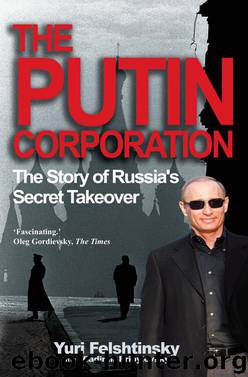The Putin Corporation by Yuri Felshtinsky

Author:Yuri Felshtinsky [Yuri Felshtinsky and Vladimir Pribylovsky]
Language: eng
Format: epub, mobi
ISBN: 9781908096265
Publisher: Gibson Square
Published: 2012-01-13T16:00:00+00:00
GUBERNATORIAL ELECTIONS IN THE SARATOV REGION AND THE KHANTY-MANSI AUTONOMOUS DISTRICT
On March 26, 2000, gubernatorial races in several regions were held concurrently with Putin’s first presidential election. The regime of “managed democracy” and the “vertical of power,” with the acting president at the top, were only a few months old, but the development of its techniques was already in full swing. The main objective of the central and local authorities was to avoid a second round in the presidential election. This objective was successfully realized, although this meant that the results had to be “corrected” by about 3 or 4 percent. A number of regional governors also took measures to ensure their own electoral futures. This was done in the most crude and dishonest fashion in two constituent subjects of the Russian Federation: the Saratov region and the Khanty-Mansi Autonomous District.
In the Saratov region, Governor Dmitry Ayatskov was running for another term. Outside the region, Ayatskov is known primarily for his proposal to legalize brothels, as well as for his statement that he is so fond of Bill Clinton that he “sincerely envies” Monica Lewinsky.
The incumbent governor (at that time, a member of the national political council of the pro-Putin Unity bloc) had one significant opponent: the leader of the local Communists, Valery Rashkin. In addition to the left-wing and protest vote, Rashkin stood to win the support of a substantial part of the liberal-minded voters concentrated in the region’s capital, who were tired of their governor’s authoritarianism and administrative caprices. Local businessmen (with the exception of those who were close to the ruling administration) also dreamed of getting rid of Ayatskov and even made secret financial contributions to the campaign of the Communist Party candidate. The only thing that put the opposition’s victory in doubt was the fact that the procedures for “correcting” election results were long established in the Saratov region.
Not wishing to rely on “correction” alone, however, the governor’s team preferred to get rid of the dangerous opponent. At the last moment, the regional election commission refused to register Rashkin as a candidate for governor on the pretext that there was “a significant number of infractions in the lists of signatures” gathered in support of his nomination. The regional court and then the Supreme Court in Moscow both rejected the Communists’ appeal.
According to the official records, Ayatskov won and approximately 20 percent of the votes were cast for “none of the above.” In reality, however, as copies of the voting records indicate, “none of the above” received a considerably greater percentage of the vote.
In the Khanty-Mansi Autonomous District, Governor Alexander Filipenko (from the Fatherland–All Russia bloc) also decided to ensure his victory by eliminating his main opponent, Sergei Atroshenko, a businessman and leader of the Russian Pensioners’ Party. Atroshenko’s platform centered on an attractive proposal to give local residents certificates—nicknamed “happiness certificates”—that would make them eligible to receive a part of the region’s oil and gas profits.
On February 18, 2000, Atroshenko registered as a candidate, but on
Download
This site does not store any files on its server. We only index and link to content provided by other sites. Please contact the content providers to delete copyright contents if any and email us, we'll remove relevant links or contents immediately.
| Arms Control | Diplomacy |
| Security | Trades & Tariffs |
| Treaties | African |
| Asian | Australian & Oceanian |
| Canadian | Caribbean & Latin American |
| European | Middle Eastern |
| Russian & Former Soviet Union |
The Secret History by Donna Tartt(18939)
The Social Justice Warrior Handbook by Lisa De Pasquale(12163)
Thirteen Reasons Why by Jay Asher(8837)
This Is How You Lose Her by Junot Diaz(6830)
Weapons of Math Destruction by Cathy O'Neil(6206)
Zero to One by Peter Thiel(5729)
Beartown by Fredrik Backman(5668)
The Myth of the Strong Leader by Archie Brown(5456)
The Fire Next Time by James Baldwin(5379)
How Democracies Die by Steven Levitsky & Daniel Ziblatt(5168)
Promise Me, Dad by Joe Biden(5111)
Stone's Rules by Roger Stone(5051)
A Higher Loyalty: Truth, Lies, and Leadership by James Comey(4903)
100 Deadly Skills by Clint Emerson(4875)
Rise and Kill First by Ronen Bergman(4738)
Secrecy World by Jake Bernstein(4698)
The David Icke Guide to the Global Conspiracy (and how to end it) by David Icke(4654)
The Farm by Tom Rob Smith(4463)
The Doomsday Machine by Daniel Ellsberg(4446)
